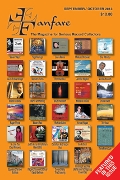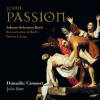Texte paru dans: / Appeared in:

Fanfare Magazine: 37:1 (09-10/2013)
Pour
s'abonner / Subscription information
Les abonnés à Fanfare Magazine ont accès aux archives du
magazine sur internet.
Subscribers to Fanfare Magazine have access to the archives of the magazine
on the net.
Linn
CKD419

0691062041928 (ID286)
How many times have you been told that you can not fully appreciate Bach’s music apart from the context of 18th-century German Lutheranism? This two-disc set is John Butt’s attempt to provide some of that context. He has tried to imagine the music that would have accompanied a performance of the St. John Passion on a Good Friday in Bach’s Leipzig. Prudently, he disavows any claims to historical accuracy—that this particular liturgy, or even the St. John Passion as recorded here, was ever performed by Bach. Unlike the St. Matthew Passion, St. John remained a work in progress throughout Bach’s life. Butt’s “idealized” version is based on Bach’s incomplete revision of 1739, but with certain modifications he made in 1749 and 1750. The ancillary music might have been performed in Bach’s time, but probably wasn’t, at least not on any particular Good Friday. Congregational chorales before and after part I of the Passion and at the end of the service are sung in unison and without accompaniment. Each is introduced by its corresponding chorale prelude by Bach. The two parts of the Passion are also introduced by chorale preludes, the first by Dietrich Buxtehude and the second by Bach. Between the conclusion of the Passion and the final congregational chorale is a closing liturgy—a brief motet by Jacob Handl Gallus, a collect, a blessing, and a briefer choral response to the blessing by Johann Hermann Schein. The liturgical pieces are sung by the University of Glasgow Chapel Choir, joined by a select group of amateur singers in the congregational chorales. Authentic or not, it’s as close to a historical Leipzig Good Friday Vespers service as we’re likely to get, and that’s no small thing.
The Passion itself is sung chamber style, with the four principal soloists, supplemented by four ripienists and two additional soloists (not drawn from the ensemble, interestingly) in the minor roles. For listeners who favor soloistic ensemble singing, this performance can only reinforce their preference. Nor will they be disappointed in the principal singers in their individual roles. Nicholas Mulroy is an earnest Evangelist and a splendid tenor soloist. Matthew Brook earns special kudos for his commanding representation of Jesus and his resonant bass arias. Clare Wilkinson is superb, too, in the alto arias. Joanne Lunn’s bright soprano is yet another asset. The instrumental ensemble—just two violinists over the minimum—excels as well. Butt, who also plays the organ chorale preludes, leads a performance that is dramatic and dynamic without calling attention to itself. It’s a laudable accomplishment.
Last
thoughts. If context is everything, this release lacks one crucial element,
that is, the sermon, which was delivered between the first and second parts
of the Passion. Butt has actually taken this into account, and so a sermon
can be downloaded—for free—from Linn’s website. The disc break comes 12
numbers into part II. It would not be impossible to listen to in its proper
order, but it would be inconvenient. Also, the Passion is sung in Bach’s
vernacular, but whether Linn’s sermon is in English or German has not been
revealed. Nor has its length. It’s been said that sermons back in the day
could run to two or three hours. And how has Lutheran theology evolved over
the centuries? So much for re-creating context. Finally, I have to say
that—strictly as a listening experience—after St John’s triumphant final
chorale, the closing liturgy came to me as a colossal anticlimax.
Recommended, nonetheless.
Fermer la fenêtre/Close window
Cliquez l'un ou l'autre
bouton pour découvrir bien d'autres critiques de CD
Click either button for many other reviews


